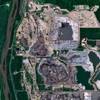U.S. Commodity ETFs Fall for Fifth Quarter
U.S. retail and institutional investors pulled cash from broad commodity exchange-traded funds for a fifth straight quarter even as coffee, natural gas and hogs prices had their best run in years, data from Thomson Reuters Lipper showed on Wednesday.
Lipper, which tracks nearly 270 U.S. exchange-traded commodity funds and products worth about $240 billion, noted a net outflow of nearly $2.7 billion in the first quarter of this year.
The data contrasts with positive flows for broad commodity exchange-traded products tracked by BlackRock for the same quarter.
With the Lipper data, the outflows were largely in two commodity ETFs run by Boston-based mutual fund manager Fidelity Investments.
The outflow appears to be slowing from the $16 billion outflow in the fourth quarter of 2013. Even so, the selling reflects continued waning appetite among investors who seem fickle on whether the commodities rally will continue.
Raw materials from coffee to lean hogs, corn, wheat, soybeans, gold and natural gas all traded sharply above analysts' estimates in the first three months of this year.
The Thomson Reuters/Core Commodity CRB Index, a closely watched gauge of commodity prices, rose nearly 9 percent for its best quarter since September 2012. The index was down through most of 2013, losing 5 percent for the year, as institutional investors pulled cash from commodity markets to chase a rally in equities.
"There's certainly a disconnect between the commodity price performance and what we have in terms of ETF flows for the first quarter," said Jeff Tjornehoj, head of Lipper Americas Research at Thomson Reuters.
"The ETF investors tend to be an institution by themselves, with flows that can be very volatile, and it's hard to understand the mood or thinking there, which can change from week to week," he added.
The highest outflow for the quarter was from Lipper's group of "General Commodity Funds," which lost a net $3.3 billion.
Although there were 145 funds in this group, nearly 80 percent of the outflows, or $2.6 billion, were from two funds: Fidelity Series Commodity Strategy Fund and Fidelity Series Commodity Strategy Fund (F).
Fidelity Investments did not respond to requests for comment.
"Energy Commodity Funds" had the second-largest outflow, losing nearly $394 million. United States Oil Fund had the biggest decline in value here, losing a net $163 million.
The outflow from the energy funds also contrasted with the broader picture in U.S. energy markets during the quarter, where oil and natural gas prices rose 3 percent each.
Fund groups that had inflows included "Precious Metals Funds", which had their first positive quarter after five quarters of outflows; and "Agriculture Funds" and "Base Metals Funds", which turned around after a year of negative flows.
"Precious Metals Funds" gained $810 million, recording their first quarterly net inflow since September 2012.
SPDR Gold Shares, the world's largest bullion-backed ETF, had the single largest net inflow, taking in $660 million.
Bullion's spot price rose almost 7 percent during the first quarter, reaching a six-month high above $1,390 an ounce.
"Agriculture Funds" gained $120 million and "Base Metals Funds" $89 million.
(Reporting by Barani Krishnan; Editing by Lisa Shumaker)












